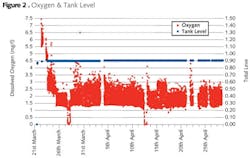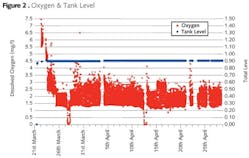Finding the most effective, reliable and economical method for separating and concentrating die lubricant is no easy task for die casting plants – and the situation at the Metaldyne aluminum die casting plant in Twinsburg, OH, was no different. For over a decade, Bill Cleary, the wastewater treatment manager, worked with 22 different wastewater treatment vendors, in addition to experts from academia and the U.S. Department of Energy to find the optimal solution for his plant.
The Twinsburg plant is a world leader in the production of aluminum valve body castings. To facilitate this process, Metaldyne has developed a world class die casting process that uses a specially formulated die lubricant, an oil and water emulsion, which helps control the temperature of the die as well as the removal of the complex castings during the part ejection process.
Each cycle of the highly-automated process begins with numerous nozzles spraying a controlled volume of lubricant onto specific locations on the die. Next, molten aluminum, at 1,250°F, is auto-ladled into the cold chamber and injected into the die under high pressure. The plant’s drainage system collects the waste generated from the casting process, including the die lubricant, as well as detergents from washing operations and glycol from the hydraulic fluid used in the robotic machinery. In addition, some process cooling water and cooling tower bleed are piped into the wastewater treatment system. The total combined wastewater flow is 9,000 to 11,000 gpd, with chemical oxygen demand (COD) ranging from 20,000 to 40,000 mg/l.
Tubular Membranes
Cleary and his team worked with almost two dozen vendors to test a wide variety of pretreatment solutions, using many different types of membranes. For example, a grant from the U.S. Department of Energy funded the testing of a spinning membrane system. The system worked effectively, but it was not commercially available and high electricity costs made the system uneconomical.
“A few years ago, we heard that a new tubular membrane was developed by Koch Membrane Systems that could handle extremely difficult oily wastewater, and indeed it proved effective,” Cleary said. “Finally, we had a system capable of removing the solids upstream of our bioreactor.”
In 2006, the Twinsburg plant installed a Konsolidator™ 150 Industrial Wastewater System from Koch Membrane Systems Inc. (KMS) of Wilmington, MA. The pre-engineered, pre-packaged system contains 150 FEG™ Plus tubular UF membranes.
KMS tubular membranes have an open channel configuration capable of handling extremely high suspended solids loads. They are well suited to applications in heavy industrial wastes including oily wastewaters and can be cleaned mechanically using spongeballs. The FEG Plus membranes are rated at 120,000 dalton molecular weight cutoff (MWCO), roughly equivalent to a membrane pore size of 0.02 microns.
New System
This new “Stage 1 UF system” removes solids and concentrates the waste 25 times, equivalent to a 96 percent reduction in water content. Cleary is investigating options for recycling the oily concentrate.
Removal of the solids enables the bioreactor process to work smoothly. Off-site disposal of bioreactor waste has been reduced tenfold, from an average of 10 truckloads per month (at a cost of $242,000/year), to only one and a half truckload per month (at a cost of $32,000/year).
Prior to the installation of the Stage 1 UF system, the MBR permeate contained a wide variation in COD levels, ranging from 1,500 to 12,000 mg/1. With the Stage 1 UF system, the MBR system now produces permeate with COD of only 30 to 300 mg/l. The MBR permeate now is well below the discharge standards set for the municipal wastewater system (COD <500 mg/l) even without polishing with RO. As a result, the RO system was shut down and permeate from the MBR is discharged directly to the sewer.
Cleary calculates that the total annual cost of off-site disposal of waste has been reduced from $332,000 to $104,000, a 69 percent reduction amounting to a savings of $228,000 per year.
“We have been able to reduce our costs and still maintain a reliable, manageable process,” Cleary said. “We went five months without asting in the bio system and without any ill effects. With the Stage 1 UF system, we finally have a process that works.”



